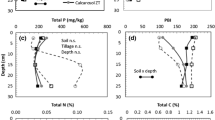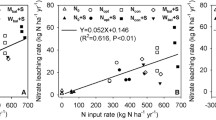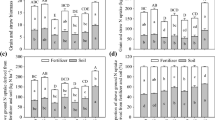Abstract
Background and Aims
Quantitative information on the fate and efficiency of nitrogen (N) fertiliser applied to coarse textured highly calcareous soils in semi-arid farming systems is scarce but, as systems intensify, is essential to support sustainable agronomic management decisions
Method
A glasshouse study was undertaken to trace the fate of N fertiliser applied to wheat (Triticum aestivum L. cv Yitpi) grown on a reconstructed profile (0 to 600 mm) of a grey highly calcareous (>35% CaCO3) sandy loam soil. Two watering treatments were applied (drier and wetter) equivalent to low (decile 2, 179 mm) and medium (decile 5, 234 mm) growing season rainfall for a location with typical semi-arid environment in southern Australia. 15 N-labelled urea fertiliser (35.4 mg N/pot) was applied in a split application - at sowing and 70 days after sowing, followed by immediate watering or watering after delay of 1 week.
Results
Recovery of N fertiliser in grain (30 to 52%) was greater for the wetter treatment, and when water was applied immediately following fertiliser application. It was also similar for N applied at sowing and N applied during crop growth. Overall, more than 40% of the urea fertiliser N remained in the soil at anthesis, largely in the top 100 mm, indicating little movement of fertiliser N down the profile even with application of water. Losses of urea fertiliser N (13-24%) were considered relatively small given the highly calcareous nature of the soil; and were significantly greater from N applied during growth compared to at sowing, particularly where watering did not immediately follow application. There was no effect of fertiliser N on grain yield due to sufficient available N in soil at sowing (139mgN/pot), but N concentration and DM of stubbles was increased. Watering treatment did not affect shoot dry matter production up to anthesis, although root weight was higher in the wetter treatment, and grain yield was 9% greater.
Conclusions
It is concluded that the potential for N losses from urea applied to highly calcareous coarse textured soils in semi-arid agricultural areas appears relatively low. Further, where there are relatively large amounts of plant available N present at sowing, a strategy of delayed or withheld applications of N to manage economic risk may have minimal effects on grain production in seasons with drier than average rainfall.





Similar content being viewed by others
References
Abdel Monem M, Lindsay WL, Sommer R, Ryan J (2010) Loss of nitrogen from urea applied to rainfed wheat in varying rainfall zones in northern Syria. Nutr Cycling Agroecosyst 86:357–366
Adcock DP (2005) Soil water and nitrogen dynamics of farming systems on the Upper Eyre Peninsula, South Australia. PhD thesis University of Adelaide. http://hdl.handle.net/2440/37810
Adcock D, McNeill AM, McDonald GK, Armstrong RD (2007) Subsoil constraints to crop production on neutral and alkaline soils in south-eastern Australia: a review of current knowledge and management strategies. Aust J Exp Agr 47:1245–1261
Anderson WK (1985) Grain yield response of barley and durum wheat to split nitrogen applications under rain-fed conditions in a Mediterranean environment. Field Crops Res 12:191–202
Angus JF (2001) Nitrogen supply and demand in Australian agriculture. Aust J Exp Ag 41:277–288
Buresh R, Vlek P, Stumpe JM (1984) Labelled nitrogen fertiliser research with urea in the semi-arid tropics I Greenhouse studies. Plant Soil 80:3–19
Buresh R, Vlek P, Harmsen K (1990) Fate of fertilizer nitrogen applied to wheat under simulated mediterranean environmental conditions. Nutr Cycling Agroecosyst 23:25–36
Colwell JD (1963) The estimation of the phosphorus fertiliser requirements of wheat in southern New South Wales by soil analysis. Aust J Exp Agric Anim Husb 3:190–198
Corbeels M, Hofman G, Van Cleemput O (1999) Fate of fertiliser N applied to winter wheat growing on a Vertisol in a Mediterranean environment. Nutr Cycl Agroecosyst 53:249–258
Coventry DR, Holloway RE, Cummins JA (1998) Farming fragile environments: low rainfall and difficult soils in South Australia. In: Proceedings of the Ninth Australian Agronomy Conference. Agronomy- Growing a Greener Future Eds. D L Michalk and J E Pratley. pp 107–116. Australian Society of Agronomy, Wagga Wagga NSW. http://www.regional.org.au/au/asa/1998/plenary/environmental/coventry.htm
Craswell ET, Godwin DC (1984) The efficiency of nitrogen fertilizers applied to cereals in different climates. Adv Plant Nutr 1:1–55
Dalgliesh NP, Foale MA (eds) (1998) Soil matters: monitoring soil water and nutrients in dryland farming. Agricultural Production Systems Research Unit, Toowoomba, Qld
Dupreez CC, Burger RD (1988) Ammonia losses from ammonium-containing and ammonium forming fertilizers after surface application at different rates on alkaline soils. Fertilizer Res 15:71–78
Evans LT, Wardlaw IF, Fischer RA (1975) Wheat. In: Evans LT (ed) Crop physiology, some case histories. Cambridge Univ. Press
Fenn LB, Miyamoto S (1979) Ammonia loss and associated reactions of urea in calcareous soils. Soil Sci Soc Am J 45:538–540
Fillery IRP (2001) The fate of biologically fixed nitrogen in legume-based dryland farming systems. Aust J Exp Agr 41:361–381
Fischer RA (1973) The effect of water at various stages of development on yield processes in wheat. In: Plant Response to Climatic Factors. Proc. Uppsala Symp. 1970, pp 233-241 UNESCO Paris
Fischer RA (1979) Growth and water limitations to dryland wheat yield in Australia: a physiological framework. J Aust Inst Agric Sci 45:83–89
Fischer RA, Maurer R (1978) Drought resistance in spring wheat cultivars I Grain yield responses. Aust J Agric Res 29:897–912
Fischer RA, Lindt JL, Glave A (1977) Irrigation of dwarf wheats in the Yaqui Valley of Mexico. Exp Agric 13:353–367
Garabet S, Ryan J, Wood M (1998) Nitrogen and water effects on wheat yield in a Mediterranean-type climate. II. Fertilizer-use efficiency with labelled nitrogen. Field Crop Res 58:213–221
Gregory PJ, Simmonds LP, Pilbeam CJ (2000) Soil type, climatic regime, and the response of water use efficiency to crop management. Agron J 92:814–820
Gupta UC, Jame YW, Campbell CA, Leyshon AJ, Nicholaichuk W (1985) Boron toxicity and deficiency: a review. Can J Soil Sci 65:281–407
Hall JAS, Maschmedt DJ, Billing NB (2009) The Soils of Southern Australia The South Australian Land and Soil Book Series Vol 1 Geological Survey of South Australia Bull.56 Vol. 1 Department of Water, Land and Biodiversity Conservation, Government of South Australia
Harmsen K (2003) A comparison of the isotopic dilution and difference method for estimating fertilizer nitrogen recovery fractions in crops. I Plant uptake and loss of nitrogen. Neth J Agric Sci 50–3/4:321–347
Harmsen K, Garabet S (2003) A comparison of the isotopic dilution and difference method for estimating fertilizer nitrogen recovery fractions in crops. III. Experimental. Neth J Agric Sci 51–3:237–261
Harmsen K, Moraghan J (1988) A comparison of the isotope recovery and difference methods for determining nitrogen fertilizer efficiency. Plant Soil 105:55–67
Harrison R, Webb J (2001) A review of the effect of N fertilizer type on gaseous emissions. Adv Agron 73:66–107
Holloway RE (1991) Factors affecting the growth of wheat roots in the subsoils of Upper Eyre Peninsula, South Australia M Ag Sci Thesis University of Adelaide
Holloway RE, Bertrand I, Frischke AJ, Brace DM, McLaughlin MJ, Shepperd W (2001) Improving fertiliser efficiency on calcareous and alkaline soils with fluid sources of P, N and Zn. Plant Soil 236:209–219
Hooper P (2010) Strategic applications of nitrogen fertiliser to increase the yield and nitrogen use efficiency of wheat. Thesis M.Ag.Sc. University of Adelaide, School of Agriculture, Food and Wine. http://hdl.handle.net/2440/62681
Isbell RF (1996) The Australian soil classification. CSIRO, Melbourne
Jones CA (1983) Effect of soil texture on critical bulk densities for root growth. Soil Sci Soc Am J 47:1208–1211
Kirda C, Derici MR, Schlepers JS (2001) Yield response and N-fertiliser recovery of rain-fed wheat growing in the Mediterranean region. Field Crops Res 71:113–122
Kirda C, Topcu S, Kaman H, Ulger AC, Yazici A, Cetin M, Derici MR (2005) Grain yield response and N fertiliser recovery of maize under deficit irrigation. Field Crops Res 93:132–141
Ladha JK, Pathak HJ, Krupnik T, Six J, van Kessel C (2005) Efficiency of fertilizer nitrogen in cereal production: retrospects and prospects. Adv Agron 87:85–156
Lombi E, McLaughlin MJ, Johnston C, Armstrong RD, Holloway RE (2004) Mobility and lability of phosphorus from granular and fluid monoammonium phosphate differs in a calcareous soil. Soil Sci Soc Am J 68:682–689
Lopez-Bellido L, Lopez-Bellido RJ, Lopez-Bellido FJ (2006) Fertilizer nitrogen efficiency in durum wheat under rainfed mediterranean conditions: effect of split application. Agron J 98:55–62
Marshall TJ, Holmes JW, Rose CW (1996) Soil physics. Cambridge University Press
Mason S, McNeill A, McLaughlin MJ, Zhang H (2010) Prediction of wheat response to an application of phosphorus under field conditions using diffusive gradients in thin-films (DGT) and extraction methods. Plant Soil 337:243–258
McDonald GK (1989) The contribution of nitrogen fertiliser to the nitrogen nutrition of rainfed wheat crops in Australia: a review. Aust J Exp Agr 29:455–81
McKenzie N, Jacquier D, Isbell R, Brown KM (2004) Australian soils and landscapes: an illustrated compendium. CSIRO, Melbourne
McNeill A, Unkovich M (2007) The nitrogen cycle in terrestrial ecosystems. In: Marschner P, Rengel Z (eds) Nutrient cycling in terrestrial ecosystems. Springer, Berlin, pp 37–64
Nix HA (1975) The Australian climate and its effect on grain yield and quality. In: Lazenby A, Matheson EM (eds) Australian field crops vol 1: wheat and other temperate cereals. Angus and Robertson, Sydney, pp 183–225
Palta JA, Fillery IRP (1995a) N-application increases preanthesis contribution of dry matter to grain yield in wheat grown on a duplex soil. Aust J Agric Res 46:507–518
Palta JA, Fillery IRP (1995b) N-application enhances remobilisation and reduces losses of preanthesis-N in wheat grwon on a duplex soil Aust. J Agric Res 46:519–531
Passioura JB, Angus JF (2010) Improving productivity of crops in water-limited environments. Adv Agron 106:37–75
Pilbeam CJ (1996) Effect of climate on the recovery in crop and soil of 15N-labelled fertilizer applied to wheat. Fertilizer Res 45:209–215
Pilbeam CJ, McNeill AM, Harris HC, Swift RS (1997) Effect of fertilizer rate and form on the recovery of 15N-labelled fertilizer applied to wheat in Syria. J Agric Sci Cam 128:415–424
Rao ACS, Smith JL, Parr JF, Papendick RI (1992) Considerations in estimating nitrogen recovery efficiency by the difference and isotopic dilution methods. Nutr Cycling Agroecosyst 33:209–217
Rayment GE, Higginson FR (1992) Australian laboratory handbook of soil and water chemical methods. Inkata, Melbourne
Ryan J, Curtin D, Safi I (1981) Ammonia volatilization as influenced by calcium carbonate particle size and iron oxides. Soil Sci Soc Am J 45:338–341
Ryan J, Ibrikci H, Sommer R, McNeill A (2009) Nitrogen in rainfed and irrigated cropping systems in the Mediterranean Region. Adv Agron 104:53–135
Sadras V (2002) Interaction between rainfall and nitrogen fertilisation of wheat in environments prone to terminal drought: economic and environmental risk analysis. Field Crop Res 77:201–215
Sadras VO, Angus JF (2006) Benchmarking water-use efficiency of rainfed wheat in dry environments. Aust J Agric Res 57:847–856
Schepers TS, Raun WA (2008) Nitrogen in Agricultural Systems. Agronomy. Monograph No. 49. Am. Soc. Agron., Crop Sci. Soc. Am., Soil Sci. Soc. Am., Madison, WI, USA
Soil Survey Staff (1999) Soil Taxonomy. A basic system of soil classification for making and interpreting soil surveys USDA-SCS Handbook Second Edition. Available online at http://soils.usda.gov/technical/classification/osd/index.html
Stephens DJ, Lyons TJ (1998) Rainfall-yield relationships across the Australian wheatbelt. Aust J Agric Res 49:211–223
Stumpe JM, Vlek PLG, Lindsay WL (1984) Ammonia volatilization from urea and urea phosphates in calcareous soils. Soil Sci Soc Am J 48:921–927
Stumpe JM, Abdel Monem M (1986) Greenhouse evaluation of the effect of topsoil moisture and simulated rainfall on the volatilization of nitrogen from surface-applied urea, diammonium phosphate and potassium nitrate. Nutr Cycling Agroecosys 9:229–239
Unkovich M, Baldock J, Forbes M (2010) Variability in harvest index of grain crops and potential significance for carbon accounting: examples from australian agriculture. Adv Agron 105:173–219
van Herwaarden AF, Farquhar GD, Angus J, Richards RA, Howe G (1998a) 'Haying-off', the negative grain yield response of dryland wheat to nitrogen fertiliser I. Biomass, grain yield, and water use. Aust J Agric Res 49:1067–81
van Herwaarden AF, Angus JF, Richards RA, Farquhar GD (1998b) 'Haying-off', the negative grain yield response of dryland wheat to nitrogen fertiliser II. Carbohydrate and protein dynamics. Aust J Agric Res 49:1083–93
Viets FG (1962) Fertilizers and the efficient use of water. Adv Agron 14:223–264
Vlek P, Fillery I, Burford J (1981) Accession, transformation, and loss of nitrogen in soils of the arid region. Plant Soil 58:133–175
Wilhelm N and Growden B (1999) Phosphorus Fertilisation for Field Crops in Difficult Soils. In Proc. 91st Annual Meeting Amer. Soc. Agron., Salt Lake City, Utah, Oct 31–Nov 4
Zapata F 1990 Isotope technique in soil fertility studies. In: Hardarson, G. (Ed.) Use of Nuclear Techniques in Studies of Soil-Plant Relationship. International Atomic Energy Agency. Training Course Series No. 2, pp 61–127
Zadoks JC, Chang TT, Konzak CF (1974) A decimal code for the growth stages of cereals. Weed Res 44:415–421
Acknowledgements
The authors wish to thank the following; Leon, Marilyn, Carolyn and Darren Mudge for providing the soil; Willie Shoobridge and other staff of Minnipa Agricultural Centre for technical assistance; Roy Latta and Murray Unkovich for reviewing earlier drafts of this manuscript; Penny Day from University of Adelaide for analyses; and UWA Biogeochem. Centre for 15N analyses. SAGIT and GRDC provided funding for this work.
Author information
Authors and Affiliations
Corresponding author
Additional information
Responsible Editor: Hans Lambers.
Rights and permissions
About this article
Cite this article
Hancock, J.M., McNeill, A.M., McDonald, G.K. et al. Fate of fertiliser N applied to wheat on a coarse textured highly calcareous soil under simulated semi-arid conditions. Plant Soil 348, 139–153 (2011). https://doi.org/10.1007/s11104-011-0917-5
Received:
Accepted:
Published:
Issue Date:
DOI: https://doi.org/10.1007/s11104-011-0917-5




